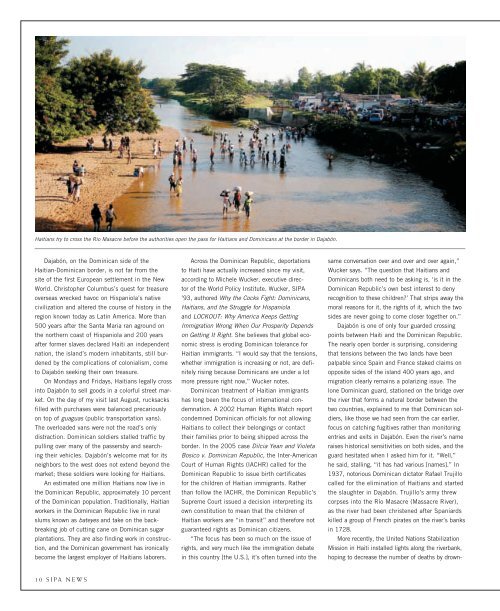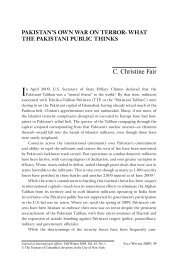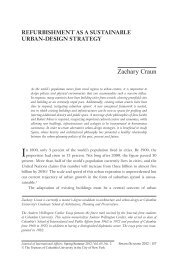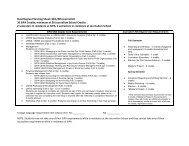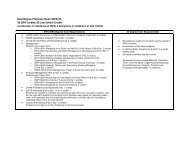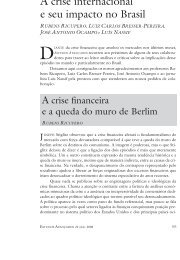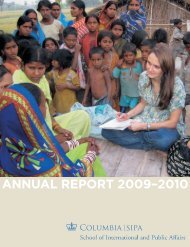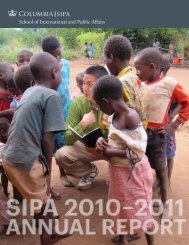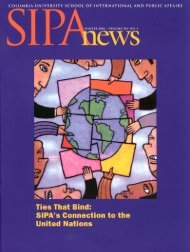SIPANEWS - SIPA - Columbia University
SIPANEWS - SIPA - Columbia University
SIPANEWS - SIPA - Columbia University
Create successful ePaper yourself
Turn your PDF publications into a flip-book with our unique Google optimized e-Paper software.
Haitians try to cross the Rio Masacre before the authorities open the pass for Haitians and Dominicans at the border in Dajabón.<br />
Dajabón, on the Dominican side of the<br />
Haitian-Dominican border, is not far from the<br />
site of the first European settlement in the New<br />
World. Christopher Columbus’s quest for treasure<br />
overseas wrecked havoc on Hispaniola’s native<br />
civilization and altered the course of history in the<br />
region known today as Latin America. More than<br />
500 years after the Santa Maria ran aground on<br />
the northern coast of Hispaniola and 200 years<br />
after former slaves declared Haiti an independent<br />
nation, the island’s modern inhabitants, still burdened<br />
by the complications of colonialism, come<br />
to Dajabón seeking their own treasure.<br />
On Mondays and Fridays, Haitians legally cross<br />
into Dajabón to sell goods in a colorful street market.<br />
On the day of my visit last August, rucksacks<br />
filled with purchases were balanced precariously<br />
on top of guaguas (public transportation vans).<br />
The overloaded vans were not the road’s only<br />
distraction. Dominican soldiers stalled traffic by<br />
pulling over many of the passersby and searching<br />
their vehicles. Dajabón’s welcome mat for its<br />
neighbors to the west does not extend beyond the<br />
market; these soldiers were looking for Haitians.<br />
An estimated one million Haitians now live in<br />
the Dominican Republic, approximately 10 percent<br />
of the Dominican population. Traditionally, Haitian<br />
workers in the Dominican Republic live in rural<br />
slums known as bateyes and take on the backbreaking<br />
job of cutting cane on Dominican sugar<br />
plantations. They are also finding work in construction,<br />
and the Dominican government has ironically<br />
become the largest employer of Haitians laborers.<br />
10 <strong>SIPA</strong> NEWS<br />
Across the Dominican Republic, deportations<br />
to Haiti have actually increased since my visit,<br />
according to Michele Wucker, executive director<br />
of the World Policy Institute. Wucker, <strong>SIPA</strong><br />
’93, authored Why the Cocks Fight: Dominicans,<br />
Haitians, and the Struggle for Hispaniola<br />
and LOCKOUT: Why America Keeps Getting<br />
Immigration Wrong When Our Prosperity Depends<br />
on Getting It Right. She believes that global economic<br />
stress is eroding Dominican tolerance for<br />
Haitian immigrants. “I would say that the tensions,<br />
whether immigration is increasing or not, are definitely<br />
rising because Dominicans are under a lot<br />
more pressure right now,” Wucker notes.<br />
Dominican treatment of Haitian immigrants<br />
has long been the focus of international condemnation.<br />
A 2002 Human Rights Watch report<br />
condemned Dominican officials for not allowing<br />
Haitians to collect their belongings or contact<br />
their families prior to being shipped across the<br />
border. In the 2005 case Dilcia Yean and Violeta<br />
Bosico v. Dominican Republic, the Inter-American<br />
Court of Human Rights (IACHR) called for the<br />
Dominican Republic to issue birth certificates<br />
for the children of Haitian immigrants. Rather<br />
than follow the IACHR, the Dominican Republic’s<br />
Supreme Court issued a decision interpreting its<br />
own constitution to mean that the children of<br />
Haitian workers are “in transit” and therefore not<br />
guaranteed rights as Dominican citizens.<br />
“The focus has been so much on the issue of<br />
rights, and very much like the immigration debate<br />
in this country [the U.S.], it’s often turned into the<br />
same conversation over and over and over again,”<br />
Wucker says. “The question that Haitians and<br />
Dominicans both need to be asking is, ‘is it in the<br />
Dominican Republic’s own best interest to deny<br />
recognition to these children?’ That strips away the<br />
moral reasons for it, the rights of it, which the two<br />
sides are never going to come closer together on.”<br />
Dajabón is one of only four guarded crossing<br />
points between Haiti and the Dominican Republic.<br />
The nearly open border is surprising, considering<br />
that tensions between the two lands have been<br />
palpable since Spain and France staked claims on<br />
opposite sides of the island 400 years ago, and<br />
migration clearly remains a polarizing issue. The<br />
lone Dominican guard, stationed on the bridge over<br />
the river that forms a natural border between the<br />
two countries, explained to me that Dominican soldiers,<br />
like those we had seen from the car earlier,<br />
focus on catching fugitives rather than monitoring<br />
entries and exits in Dajabón. Even the river’s name<br />
raises historical sensitivities on both sides, and the<br />
guard hesitated when I asked him for it. “Well,”<br />
he said, stalling, “it has had various [names].” In<br />
1937, notorious Dominican dictator Rafael Trujillo<br />
called for the elimination of Haitians and started<br />
the slaughter in Dajabón. Trujillo’s army threw<br />
corpses into the Río Masacre (Massacre River),<br />
as the river had been christened after Spaniards<br />
killed a group of French pirates on the river’s banks<br />
in 1728.<br />
More recently, the United Nations Stabilization<br />
Mission in Haiti installed lights along the riverbank,<br />
hoping to decrease the number of deaths by drown-


